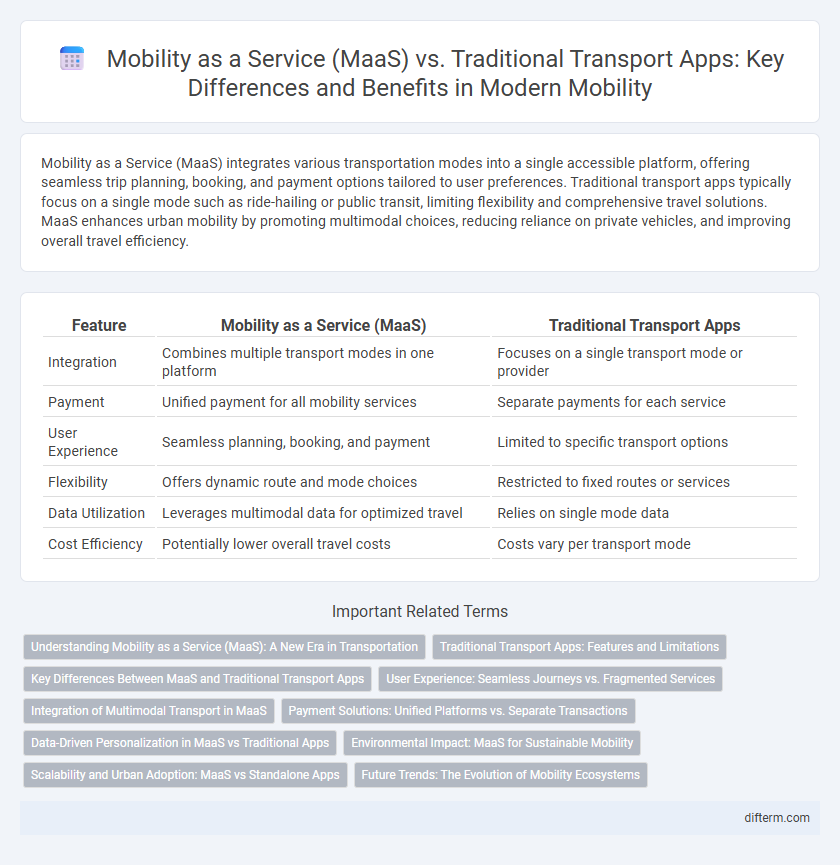Mobility as a Service (MaaS) integrates various transportation modes into a single accessible platform, offering seamless trip planning, booking, and payment options tailored to user preferences. Traditional transport apps typically focus on a single mode such as ride-hailing or public transit, limiting flexibility and comprehensive travel solutions. MaaS enhances urban mobility by promoting multimodal choices, reducing reliance on private vehicles, and improving overall travel efficiency.
Table of Comparison
| Feature | Mobility as a Service (MaaS) | Traditional Transport Apps |
|---|---|---|
| Integration | Combines multiple transport modes in one platform | Focuses on a single transport mode or provider |
| Payment | Unified payment for all mobility services | Separate payments for each service |
| User Experience | Seamless planning, booking, and payment | Limited to specific transport options |
| Flexibility | Offers dynamic route and mode choices | Restricted to fixed routes or services |
| Data Utilization | Leverages multimodal data for optimized travel | Relies on single mode data |
| Cost Efficiency | Potentially lower overall travel costs | Costs vary per transport mode |
Understanding Mobility as a Service (MaaS): A New Era in Transportation
Mobility as a Service (MaaS) integrates various transportation modes--such as buses, trains, ride-sharing, and bike rentals--into a single, user-friendly digital platform, revolutionizing urban mobility. Unlike traditional transport apps that focus on individual services, MaaS provides seamless planning, booking, and payment solutions, enhancing convenience and efficiency. This unified approach fosters reduced traffic congestion, lower carbon emissions, and greater accessibility for all urban dwellers.
Traditional Transport Apps: Features and Limitations
Traditional transport apps primarily focus on single-mode transportation options such as ride-hailing, public transit schedules, or bike rentals, lacking integrated multimodal journey planning. These apps often have limited real-time data accuracy, resulting in suboptimal route suggestions and user experience. The absence of seamless booking and payment systems across different transport modes restricts user convenience and efficiency compared to Mobility as a Service (MaaS) platforms.
Key Differences Between MaaS and Traditional Transport Apps
Mobility as a Service (MaaS) integrates multiple transportation modes such as buses, trains, ride-sharing, and bike rentals into a single, seamless platform, enabling users to plan, book, and pay for a complete journey through one app. Traditional transport apps typically focus on a single mode of transportation, limiting user choices and requiring multiple apps for multi-modal trips. MaaS enhances convenience, efficiency, and sustainability by providing personalized route options and real-time updates, contrasting with the isolated, mode-specific information offered by conventional transport applications.
User Experience: Seamless Journeys vs. Fragmented Services
Mobility as a Service (MaaS) offers users seamless journeys by integrating multiple transport modes into a single platform, eliminating the need for separate bookings and payments. Traditional transport apps typically provide fragmented services, requiring users to switch between different applications for buses, trains, and rideshares, which disrupts the travel experience. Enhanced user experience in MaaS platforms drives higher satisfaction through real-time updates, unified ticketing, and personalized route planning.
Integration of Multimodal Transport in MaaS
Mobility as a Service (MaaS) integrates multimodal transport options such as buses, bikes, trains, and ride-sharing into a single, user-friendly platform, enhancing seamless travel planning and payment processes. Unlike traditional transport apps that typically focus on one mode of transportation, MaaS platforms consolidate real-time data and ticketing across diverse transport networks, optimizing route efficiency and user convenience. This integration reduces reliance on private vehicles, promoting sustainable urban mobility and lowering overall carbon emissions.
Payment Solutions: Unified Platforms vs. Separate Transactions
Mobility as a Service (MaaS) platforms streamline payment solutions by offering unified platforms that integrate multiple transport options into a single transaction, enhancing user convenience and reducing friction. Traditional transport apps typically require separate payments for each mode of transport, leading to fragmented user experiences and increased transaction times. Unified payment systems within MaaS also enable better data integration for service providers, optimizing route planning and customer insights.
Data-Driven Personalization in MaaS vs Traditional Apps
Mobility as a Service (MaaS) leverages advanced data analytics and real-time information to offer highly personalized travel options tailored to individual user preferences, combining multiple transport modes within a single platform. Traditional transport apps typically provide static schedules and route information with limited customization, relying largely on predefined data sets rather than continuous user behavior analysis. The data-driven personalization in MaaS enhances user experience by dynamically adapting services based on location, traffic conditions, and user habits, resulting in more efficient and seamless mobility solutions.
Environmental Impact: MaaS for Sustainable Mobility
Mobility as a Service (MaaS) integrates diverse transport modes into a single platform, significantly reducing carbon emissions by optimizing route planning and minimizing unnecessary trips. Unlike traditional transport apps that often focus on single modes like ride-hailing or public transit, MaaS promotes multimodal journeys prioritizing low-emission options such as biking, walking, and electric vehicles. This holistic approach contributes to sustainable urban mobility by lowering traffic congestion and improving air quality.
Scalability and Urban Adoption: MaaS vs Standalone Apps
Mobility as a Service (MaaS) platforms offer greater scalability by integrating multiple transport modes, enhancing urban adoption through seamless multimodal journey planning. Unlike traditional standalone transport apps that focus on single modes, MaaS solutions adapt dynamically to growing urban demand and complex travel patterns. This integrated approach reduces congestion and promotes sustainable mobility in expanding metropolitan environments.
Future Trends: The Evolution of Mobility Ecosystems
Mobility as a Service (MaaS) platforms are revolutionizing future mobility ecosystems by integrating multimodal transport options into seamless, user-centric digital interfaces, contrasting with traditional transport apps that typically focus on single-mode services. Advanced technologies such as AI-driven predictive analytics, real-time data integration, and blockchain for secure transactions are driving the evolution toward interconnected, adaptive mobility solutions. This shift enables enhanced urban mobility efficiency, reduced environmental impact, and personalized travel experiences, positioning MaaS as a pivotal component in sustainable smart city development.
Mobility as a Service (MaaS) vs traditional transport apps Infographic

 difterm.com
difterm.com